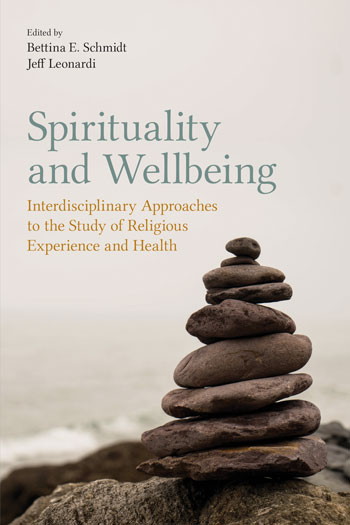Spirituality and Wellbeing
This book shows how the relationship between wellbeing and spirituality is studied by a range of disciplines including religious studies, theology, anthropology, psychology and history
 Spirituality and Wellbeing: Interdisciplinary Approaches to the Study of Religious Experience and Health
Spirituality and Wellbeing: Interdisciplinary Approaches to the Study of Religious Experience and Health
Edited by Bettina Schmidt and Jeff Leonardi
Equinox Publishing, Sheffield
ISBN: 9781781797648
Reviewed by Alec Gilmore
If you are looking for a definition of two weasel words (Spirituality and Wellbeing) you are not likely to find it here. Schmidt and Leonardi’s concern is what Spirituality does not what it is and with Wellbeing as a consequence not a target. ‘By their fruits . . .’.
The nearest we get to a definition is from China where Wellbeing is seen more as a process than a goal, with ‘well-becoming’ a more helpful alternative, and earthed in the the Miaoshan Legend, symbolising general human concerns and ‘nested cultural characteristics (motherhood, spiritual aspirations, physicality, social engagement), along with other Chinese deities including the Venerable Mother, ‘the mediator for spiritual enlightenment and worldly happiness’.
Brazil has a different take. When asked how Spirituality led to improved Wellbeing, answers included ‘it creates a focus beyond one’s self’. . .‘provides mental and emotional stability’. . . ‘highlights a sense of purpose’. . .‘knowing that one is not alone’. . .(and) ‘improves our relationship with the world and people’. Others mentioned Spirituality’s impact on the physical Body and group gatherings reenforcing the message that the most ‘powerful force’ is love.
Nearer home the territory is equally wide-ranging, much of it often sitting lightly (if at all) on the fringes of church life. Clinical Parapsychology, for example, responds to people with all kinds of experiences, including ‘hearing voices’ and ‘seeing things,’ all more common than we think and too readily dismissed as ‘just odd’. Maybe step one on the road from Spirituality to Wellbeing here is sympathetic listening, believing what they say and a simple acceptance of their condition. Step two may be finding ways to integrate them into the company.
Concern for ‘the Body’ is another example of our lacklustre approach, especially our understanding of humanity, mental health in general and sexuality in particular, which is surprising for a people whose foundation stone is that we were created ‘in the image of God’ and whose gospel is incarnation (God in flesh). Step one here may be a bit of enlightened theology including a more healthy balance between the material and the spiritual. Both Spirituality and Wellbeing are presented as highly relevant issues for churches and individual members, but how might they fit into a local church programme? One way might be a review to address the question ‘how spiritual is our church?‘
Two or three members might reflect on these essays and compile a list of items raised under three headings: what we do, what we don’t do, and what we had never thought of but might tackle. Another potential Beacon of Hope to ‘turn a spark into flame.'
Alec Gilmore is a Baptist minister
Baptist Times, 18/09/2020